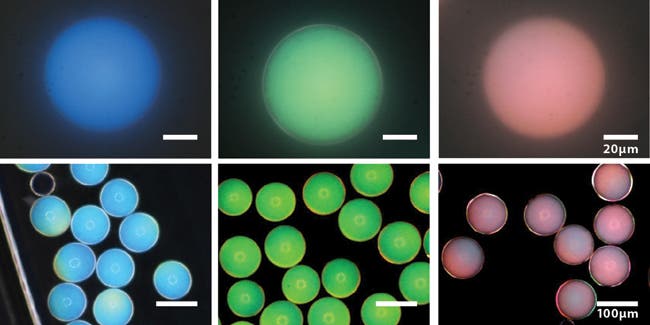
These photonic microcapsules have been prepared to produce blue, green, and red structural colors and imaged using bright-field (top) and dark-field (bottom) optical microscopy. (Images courtesy of Jin-Gyu Park.)
A team of Harvard engineers has developed a way of producing color that could produce paint that never fades, and displays that never go dark.
How color works
If you’ve never wondered how color works, it’s a pretty nifty thing. The color we usually see, like on paints and trees works by absorbing certain wavelengths of light and reflecting the remainder.
“What that means is that the material is absorbing some energy, and that means that over time, the material will fade,” says Vinothan N. Manoharan, a researcher at Harvard’s School of Engineering and Applied Science who’s leading the effort.
However, there’s more than one type of color. For example, you also have structural color, which occurs when an object’s very nanostructure amplifies a specific wavelength; for example, peacock tail feathers are pigmented brown, but their structure makes them appear blue, turquoise, and green, and often they appear iridescent. This coloration never wears out.
Bird inspiration
Many birds exhibit this type of coloration – and this is what the team went for here. Researchers led by Vinothan N. Manoharan at the Harvard School of Engineering and Applied Sciences want to recreate this effect, giving man-made materials structural color.
Basically, the team devised a system where microcapsules are filled with a disordered solution of even smaller particles suspended in water. When the microcapsule dries out, it shrinks, bringing the particles closer and closer together. When they get close enough, they start giving out certain colors. Shrink the capsule a bit more, and they become another color, and then another, and so on – until you pass through the entire spectrum.
“There’s an average distance between particles, even though there is no ordering in the particles. It’s that average distance that is important in determining the color,” says Manoharan, Gordon McKay Professor of Chemical Engineering and Professor of Physics at Harvard.
The awesome thing about this method is that it doesn’t fade away – because of its structural nature.
“We think it could be possible to create a full-color display that won’t fade over time,” says Manoharan. “The dream is that you could have a piece of flexible plastic that you can put graphics on in full color and read in bright sunlight.” Paint and ink that never fade are also a possibility.
Via Harvard.
Scientific Paper.










